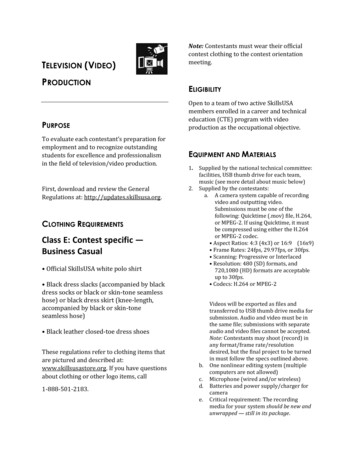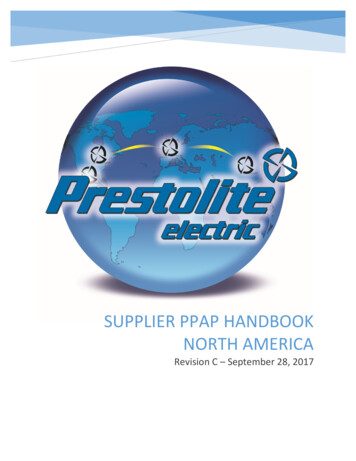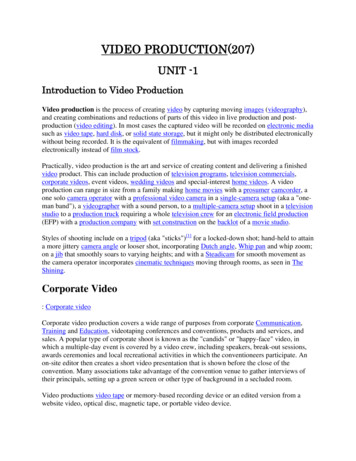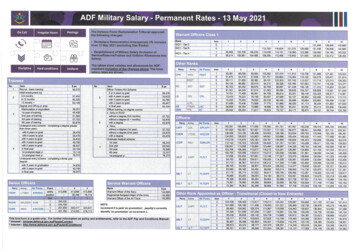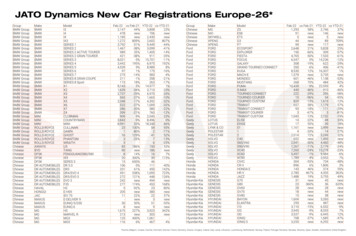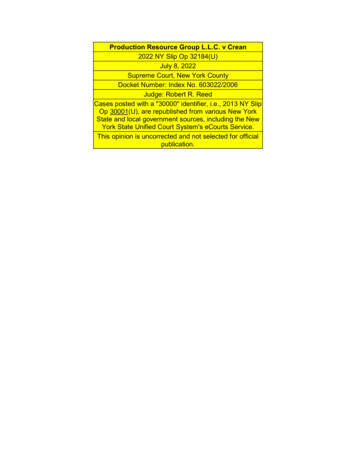
Transcription
Production Resource Group L.L.C. v Crean2022 NY Slip Op 32184(U)July 8, 2022Supreme Court, New York CountyDocket Number: Index No. 603022/2006Judge: Robert R. ReedCases posted with a "30000" identifier, i.e., 2013 NY SlipOp 30001(U), are republished from various New YorkState and local government sources, including the NewYork State Unified Court System's eCourts Service.This opinion is uncorrected and not selected for officialpublication.
INDEX NO. 603022/2006NYSCEF DOC. NO. 368RECEIVED NYSCEF: 07/08/2022SUPREME COURT OF THE STATE OF NEW YORKCOUNTY OF NEW YORK: PART --------------------XPRODUCTION RESOURCE GROUP L.L.C. D/B/ASCENIC TECHNOLOGIES,Plaintiff,Index No.: 603022/2006DECISION AFTERNON-JURY TRIAL-v-ROBERT CREAN, ADVANCED ANIMATIONS,ADV AN CED ---------------------------------------- --- ·-XROBERT R. REED, J.S.C.:This is a breach of contract case involving the development of a perimeter safety systemfor theatrical lifts at the Le Reve Aqua Theatre, located at the Wynn Resort in Las Vegas,Nevada. A bench trial was held from September 16, 2014 through December 12, 2014. For thereasons set forth below, the court finds in favor of defendants Robert Crean and AdvancedAnimations LLC.BACKGROUNDPlaintiff Production Resource Group LLC ("PRG") is an entertainment technologycompany specializing in lighting, sound, and specialty construction for large scale entertainmentand themed events. Defendant Advanced Animations LLC ("AA") is an animatronics companythat creates animated figures and interactive exhibits for major theme parks, casinos and otherretail and trade show events. Defendant Robert Crean ("Crean") was vice president of operationsfor Advanced Animations.603022/2006[* 1]Production Resource Group LLC vs. Robert Crean, et. al.1 of 25Page 1 of 25
INDEX NO. 603022/2006NYSCEF DOC. NO. 368RECEIVED NYSCEF: 07/08/2022PRG contracted with the Wynn resort to design an underwater hydraulic lift system to beutilized during an entertainment piece at the hotel. Wynn's design team prepared the conceptdrawings, and PRG was responsible for the development, fabrication, and installation of thesystem.PRG retained AA to develop and construct a safety system for the lift. Performance underthe contract took place in stages. AA and PRG conferred on what materials to use, what designspecifications were required, and PRG reviewed the final switch assemblies produced by AA inMay of 2004. AA's project was fully delivered to PRG in the summer of 2004.PRG commenced this action three years later alleging AA's system did not work. PRGclaimed that AA furnished defective and substandard components, and negligently designed thesafety system. According to the complaint, as a result of AA's purp0rted failures, PRG wasrequired to incur expense redesigning and completing the system.PRG proceeded to trial against AA on a single claim of breach of contract.FINDINGS OF FACTUpon the evidence submitted at trial, the court makes the following findings of fact:1.In 2002, PRG won a bid to design and build a hydraulic lift system for the LeReve Aqua Theatre, located at the Wynn Resort in Las Vegas, Nevada (PTXl).2.PRG had overall responsibility for the design, development, and installation of theproject (PTX 3).3.In accordance with PRG's agreement with Wynn resort, PRG was required todevelop a safety system for use with the lifts (PTX 3).4.In May of 2003, an engineer with PRG arrived at the concept for the design of aperimeter safety system (DTXE; Tr. 215:15-26 (Lehner)).603022/2006[* 2]Production Resource Group LLC vs. Robert Crean, et. al.2 of 25Page 2 of 25
INDEX NO. 603022/2006NYSCEF DOC. NO. 3685.RECEIVED NYSCEF: 07/08/2022In June of 2003, PRG contacted AA seeking assistance with design concepts forthe system (Tr. 1675:10-22, 1677:11-25 [Crossley]).6.PRG conferred with defendant Robert Crean, an employee of AdvancedAnimations LLC (Tr. 1241 :24-1242:7 [Crean]). At all relevant times, Crean was acting withinthe scope of his employment as Vice President of Operations (Tr. 1336:25-1337:16 [Crean]).7.PRG prepared a scope of work that set forth, in phases, what AA's work on thesystem would entail (Tr. 1246:23-1247:11 [Crean]).Contract Agreement .and Performance8.The scope of work "description" provides "[d]evelop and manufacture a perimetersafety system to protect against personal injury and property damage for a series of theatricalstage lifts."9.Development for the perimeter safety system was to proceed in phases identifiedas: (1) proof of concept; (2) development and documentation, and (3) prototype production andmanufacture of deliverable items (PTX 4).10.By letter dated June 16, 2003, AA offered to perform eight tasks identified in thefirst proof of concept phase, for 11,500.00 (PTX 5).11.On June 17, 2003, PRG accepted the,offered terms (PTX 6), and paid an initialinvoice of 5,750 (PTX 7).12.In phase one, AA was responsible for:1. Review the specifications, operational requirements and constructiondocuments for the pool lift system.2. Review the pool environment, corrosion protection concerns, electricalbonding requirements and STI control philosophy.3. Review the concept drawings for the proposed pressure sensitive facing: PLSV-9-200 and PLS. V-9-210.4. Participate in identifying a list of performance specifications for evaluation ofthe system. These parameters may include:603022/2006[* 3]Production Resource Group LLC vs. Robert Crean, et. al.3 of 25Page 3 of 25
INDEX NO. 603022/2006NYSCEF DOC. NO. 368RECEIVED NYSCEF: 07/08/2022a.b.c.d.e.5.6.7.8.Physical dimensionsMinimum operating pressureMinimum impact velocityTravel after contactInsensitivity to ambient pressuref. Level of redundancyg. External appearanceDevelop a plan for proving the viability of these concepts with physicalprototypes and testing as may be required. Testing should include:a. Operation at various speeds including the maximum vertical velocityof 6 in/sec in both lifting and lowering directions.b. Operation in and out of waterc. "Splashdown," where the water is entered (or left) at maximumvelocity.d. Underwater operation at a minimum water depth of2l '-6"Prepare and test the physical prototypes. Iteration may be required in order toachieve a successful prototype.Report on the outcome of the testing by preparing written descriptions andvideo·ofthe outcome.Prepare a cost estimate for the Development and Documentation phase"(PTX 4).13.AA built an initial prototype consisting of: (1) a tapeswitch-brand switch; (2)open-cell foam to provide for "overtravel," and (3) fabric to encase the switch and foam (Tr.1259:8-11; 1260:20-1261 :4 [Crean]).14.AAwet-tested the prototype at its facilities with PRG present (Tr. 1251:16-20[Crean]). The switch assembly worked as intended (Tr. 1721 :4-14 [Crossley]).15.PRG and AA discussed additional testing but did not arrive at any finalconclusions (Tr. 1223:15-19 [Crossley]; Tr. 1720:21-23 [Crossley]; Tr. 1259:16-24 [Crean]). AAshipped the prototype to PRG for further testing (PTX 8, Tr. 62: 14-19; 63 :24-64:7; Tr. 231 :22-23[Lehner]; Tr. 1261:10-19 [Crean]).16.On July 25, 2003, PRG met with Wynn representatives at PRG's facilities in NewWindsor, New York. At the meeting, PRG presented two fabricated mock-ups for the purpose of603022/2006[* 4]Production Resource Group LLC vs. Robert Crean, et. al.4 of 25Page 4 of 25
INDEX NO. 603022/2006NYSCEF DOC. NO. 368RECEIVED NYSCEF: 07/08/2022testing and reviewing (DTX L; Tr. 235:2-8 [Lehner]). PRG presented AA's mock-up, and a· mock-up of a mercury switch that PRG designed (Tr. 65: 13-66: 15 (Lehner]).17.AA was not invited to attend the meeting with PRG and Wynn (Tr. 1261 :20-21[Crean]; DTX L).18.AA's switch assembly prototype was accepted by PRG and Wynn (Tr. 236:22-237:24 [Lehner]). PRG abandoned its mercury-switch concept (Tr. 1697:16-22; 1698:6-9 [Gray];DTXL).19.PRG did not require AA to perform any additional testing in the first phase of thescope of work agreement (Tr. 227:14-23; Tr. 469:4-8 [Lehner]; Tr. 1260:12-14 [Crean]; Tr.1690:5-16; 1688:23-1689:8; Tr. 1223:12-19 [Crossley]).20.On August 4, 2003, PRG approved payment of the balance due to AA for the firstphase of the scope of work (PTX 8, Tr. 62:14-19; Tr. 63:24-64:17 [Lehner]).21.In August 2003, PRG sent AA a revised Scope of Work that included eleven tasksfor the second phase of AA's work onthe project (PTX 9, Tr. 68:9-22.)22.On August 25, 2003, AA sent PRG a letter offering to perform the eleven tasksidentified in the revised scope of work for a price of 6,950.00, subject to changes in thedeadlines proposed by PRG (PTX 9).23.On September 2, 2003, PRG approved an invoice for 50% of the price (PTX 10;Tr. 80:22-81:17; Tr. 1274:4-5 [Crean]).24.PRG conducted further testing of AA's initial prototype on August 5, 2003 (Tr.238:11-15; 239:7-18 [Lehner]). PRG forwarded comments received from Wynn regarding theprototype and provided to AA comments based upon its own internal testing (Nov. 3 Tr.603022/2006[* 5]Production Resource Group LLC vs. Robert Crean, et. al.5 of 25Page 5 of 25
INDEX NO. 603022/2006NYSCEF DOC. NO. 368RECEIVED NYSCEF: 07/08/20221263:15-26; 1264:15-17; 1265:10-19; 1271:10-18[Crean]; Tr. 800:5-11; 798:20-23 [Aubry]; Tr.255:18-26 [Lehner]).25.Based upon the comments and internal testing, PRG requested changes to the firstprototype (Tr. 800:16-22 [Aubry]; Tr. 1271:10-22 [Crean]). PRG requested: (1) reduction of thedrip rate (Tr. 800:16-22 [Aubry]; Tr. 1271: 10-22 [Crean]); (2) use of closed cell foam material(Tr. 1263:15-26; 1275:9-12; Tr. 1380:6-11 [Crean]); (3) use of non-metallic fasteners in theproduction switch assemblies (PTX 9; Tr. 1296:2-9 [Crean]); (4) use of a seacon connector forthe switch assemblies (Tr. 702:12-21 [Pierce]); (5) use of mesh or other permeable fabric (Tr.1275:9-22 [Crean]), and (6) other aesthetic changes to the switch assemblies (Tr. 1699:21-1700:4[Gray]; Tr. 43:15-18; 46:22-47:4. [Lehner]).26.AA fabricated a second.prototype and sent the second prototype to PRG for re-testing (Tr. 1275:2-1276:13 [Crean]; PTX 12; Tr. 87:17-88:6; Tr. 1276:10-13; PTX 18; Tr.101 :23-102:18).27.AA was not present for PRG's testing of the second prototype (Tr. 1276:10-13[Crean]).28.PRG was satisfied with AA's performance on the second phase of the agreement.PRG approved and paid AA's invoices for its work on September 2, 2003, and October 10, 2003(PTX 1O; PTX 11, Tr. 80:22-26; 82:20-26).29.By letter dated October 2, 2003, AA offered to manufacture the approvedmodified switch assemblies for a price of 70,678.00 (PTX 12).30.PRG accepted AA's offer on December 11, 2003 by issuing the first in a series ofpurchase orders to AA (PTX 13, 15, 16, 18, 22). In its purchase orders, PRG instructed AA to603022/2006[* 6]Production Resource Group LLC vs. Robert Crean, et. al.6 of 25Page 6 of 25
INDEX NO. 603022/2006NYSCEF DOC. NO. 368RECEIVED NYSCEF: 07/08/2022make improvements identified in the second phase of the agreement and incorporate changesresulting from PRG's testing of the second prototype (PTX 13, PTX 16, PTX 18; PTX 22).31.AA modified and fabricated the switch assemblies to implement the designchanges PRG specified in its purchase orders (DTX NNN; Tr. 1287:4-20, 1289:24-1290:5[Crean]). To do so, AA relied on technical drawings from PRG (DTX AAA; Tr. 1434: 191435:11 [Conley]). The drawings provided specific measurements that were then forwarded,without substantive modification, to AA's vendors for manufacture. The pieces were assembledby AA (Tr. 1435:25-1438:9 [Conley]).32. ·On May 13, 2004, PRG reviewed the modified switch assemblies and performedan "acceptance test" (PTX 24; DTX NNN, Tr. 1682:26-1683-13 [Crossley]; Tr. 810:9-20[Aubry]; Tr. 112:21-113:12 [Lehner]).33.AA arranged the switch assemblies on a template to show PRG how they wouldbe aligned underneath the lifts (Tr. 1288:11-1289:5 [Crean]). Photographs taken during the visitshow the assemblies adhered to one another (DTX LL).34.PRG accepted the assemb.lies and AA shipped them to PRG on May 17, 2004 (Tr.811: 11-15 [Aubry]; PTX 24; Tr. 111: 18-112:12 [Lehner]; Tr. 1290:24-25 [Crean]).3 5.On or about May 21, 2004, PRG advised AA that some of the switch assemblieswere damaged during shipping (PTX 26, Tr. 125:22-126:11 [Lehner]; Tr. 1291:3-11 [Crean]).PRG shipped the damaged bags back to AA, and AA repaired them (Tr. 1291 :15-17; 1292:141293:2 [Crean]; Tr. 129:22-130:11 [Lehner]; Tr. 815:22-25 [Aubry]).36.Between June 24, 2003, and May 10, 2004, AA issued nine invoices to PRG(PTX 7, 8, 10, 11, 14, 19, 20, 23, 24). PRG paid all of AA's invoices for the third (and final)phase of work in the agreement (Tr. 113:13-18; 115:5-8 [Lehner]).603022/2006[* 7]Production Resource Group LLC vs. Robert Crean, et. al.7 of 25Page 7 of 25
INDEX NO. 603022/2006NYSCEF DOC. NO. 36837.RECEIVED NYSCEF: 07/08/2022The last payment was made to AA on May 10, 2004, following completion ofadditional acceptance testing by PRG (PTX 24; Tr. 112:13-20 [Lehner]).38.AA was paid a total of 124, 585.10 for all three phases of work (PTX 25).39.PRG did not require onsite testing in Las Vegas prior to payment of AA'sinvoices (PTX 12; PTX 13; PTX 16; PTX 18; PTX 22).Problems with the Perimeter Safety System40.Installation of the prototype was performed by PRG (Tr. 502:20-24; 505 :9-17[Pierce]). AA was not present for and did riot participate in the installation (Tr. 1293:3-1294:23[Crean]; DTX PP, Tr. 1315:2-14; PTX 4; PTX 9).41.On July 16, 2004, PRG notified AA of the following problems with the prototype:(1) Velcro was coming open; (2) there was visible safety bag deformation, and (3) false tripping. (PTX 27, Tr. 131 :13-18). PRG requested that AA repair the prototype in Las Vegas.42.On August 30, 2004, AA visited the Wynn theatre to observe the condition ofthe prototype (1302:9-10). AA took photographs of the visit (DTX 00).43.During the visit, several problems with the prototype were identified: (1) theswitch assemblies were not properly installed and aligned; (2) the bags had significant gapsbetween them at different locations on the lifts; (3) the fascia was not installed correctly; (4) thewiring of the safety system was faulty, and (5) a donut lift utilized onsite experienced lateralmovement, causing the fascia to scrape during movement (DTX 00, Tr. 690:25-691 :5-26692:11- 18 [Pierce], 1258:11-14, 1304:18-1305:9-17, 1306:9-111309:9-13, 1310:17-241325:416 [Crean]).44.AA sent field technician Christopher Nolan to Las Vegas to inspect the prototypeand make repairs (Tr. 1444:3-19 [Nolan]). When he arrived, Nolan observed several conditions603022/2006[* 8]Production Resource Group LLC vs. Robert Crean, et. al.8 of 25Page 8 of 25
INDEX NO. 603022/2006NYSCEF DOC. NO. 368RECEIVED NYSCEF: 07/08/2022that were unrelated to AA's work on the prototype. The foam boxes were dirty (Tr.1447:4-8),seacon connectors were damaged (Tr.1447:21-1448:4), wires were exposed, and open connectorswere underwater (Tr. 1312: 15-25 [Crean]).45.Nolan spent two weeks at PRO's shop in Las Vegas, where he inspected thesafety switches, reinforced the foam boxes, replaced several tapeswitches and added stainlesssteel fasteners to the textilene bags (Tr. 1444:3-1445:8 [Nolan]).46.AA and PRO continued to work together on a new prototype design using open-cell foam to replace the closed-cell foam boxes (Tr. 1319: 18-26 [Crean]). AA proposed a switchassembly design that included a revised mounting system and use of open-cell foam (DTX RR,Tr. 1317:25-1318:16; 1319:6-9 [Crean]). AA also continued to perform testing on thetapswitches to determine what was causing the false tripping (Tr. 1407:17-1408:10; 1322:111323:26 [Crean]).47.In November of 2004, AA sent another field technician to Las Vegas to assistPRG in the reconstruction of the switch assemblies (Tr. 1326:2-4, 1419:9-11 [Crean], 1414:8-12[Abar, by deposition designation]).48.AA's involvement with the perimeter safety system switch assemblies came to anend around February 18, 2005, after PRO failed to respond to AA's offer of continued assistancewith the switch assembly replacement (DTX XX, Tr.1333:4-18; 1334:9-1335:4 [Crean]).Responsibility for Prototype Malfunction49.Daniel Birket, a certified functional safety engineer, provided testimony as anexpert in safety and control systems (Tr. 1485:17-19; 1488:16-24 1490:4-10; 1493:21-23[Birket]).603022/2006[* 9]Production Resource Group LLC vs. Robert Crean, et. al.9 of 25Page 9 of 25
INDEX NO. 603022/2006NYSCEF DOC. NO. 368RECEIVED NYSCEF: 07/08/202250.Birket testified that AA supplied only one component of the safety system toPRG. AA supplied the tapeswitch sensor, and confirmed that it "was quite suitable, properlyapplied" (Tr. 1508:11-21,1509:11-18, 20-22 [Birket]).51.PRG was solely responsible for installation of the switch assemblies (Tr. 502:20-24; 505 :9-17 [Pierce]). PRG prepared the schematics that set forth how the tapeswitches shouldbe wired (Tr. 1470:7-12; 1472:26-1473:7; 1473:14-17 [Galante]).52.Birket opined that PRG's improper assembly of the system resulted in low currentand tripping of the electrical circuit. He confirmed that problems with the design and wiring ofthe system reimlted-in malfunction (Tr. 1504:21-25 1505:4-1506:4, 1514:11-18, 1578:16- 19;\'1579:4-5; 20; 1580:16-25; 1587:12-22 [Birket]).53.Birket testified that, to a reasonable degree of scientific certainty, the reliabilityproblems with the safety system were caused by wiring too many tapeswitches on a circuit. Itwas PRG's decision to wire the tapeswitches in a daisy chain series (Tr. 1523:6-12; Tr. 1574: 1519 [Birket]).54.AA had no responsibility with respect to the controller or the wiring of theperimeter safety system (PTX 4, PTX9, Tr. 1258:11-14; Tr. 1325:4-16 [Crean]).55.Early in the design process, AA advocated using a "Guardstar" controller madeby tapeswitch for use with its switches (Tr. 1679:13-16; 1678:25-1679:7; 1679:20-26 [Crossley];Tr. 1257:21-1258:7 [Crean]). The Guardstar controller is designed to handle up to fourtapeswitches on a single circuit. (Tr. 1313:24-1314:7 [Crean]).56.Birket testified that the Guardstar interface supplied by the tapeswitchmanufacturer should have been used in the Le Reve Aqua Theater pool system and would haveresolved the problem of interfacing the Tapeswitches correctly (Tr. 1543:9-23 [Birket]).603022/2006[* 10]Prod ction Resource Group LLC vs. Robert Crean, et. al.10 of 25Page 10 of 25
INDEX NO. 603022/2006NYSCEF DOC. NO. 36857.RECEIVED NYSCEF: 07/08/2022PRO's operation manager testified that workers were not able to install the safetybags so that they were flush with the fascia, as per the design drawings. Design drawings wereprepared by PRO (Tr. 690:25-691 :5-26 692: 11- 18 [Pierce]).58.PRO admitted that the lateral movement of the donut lift was an issue thatpreceded AA' s involvement with the project. The issue was not resolved until September of2004, after the installation of AA's safety bags and prototype (DTX R; 385:16-23, 387:9-12[Lehner]; 698:21- 699:14; 777:14-778:6; 756:19-26 [Pierce]).Damages and Remediation Costs59.PRO compiled purchase orders, checks and documents reflecting costs associatedwith remediating the perimeter safety system. The documents reflected isolated charges thatwere purportedly attributable to AA's work on the safety system (PTX 35, PTX84, DTX 0,170:22-25, 172:7-12, 269:22-270: 16 [Lehner]).60.PRO Senior Vice President of design and build for global events later admittedthat numerous invoices asserted as damages by PRO, predated the installation of the perimetersafety system and were not related to PRO's remediation (24:4, 272:15-273:4 [DTX OatP2001]; 273:5-274:12 [DTX Oat P2007]; 274:13- 275:10 [DTX Oat P2010]; 303:17-305:6[DTX Oat P2247-2248]; 305:7-22; 306:3-12 [DTX Oat P2249]; 306:13-22 [DTX Oat P2321];306:23-307:7 [DTX Oat P2325]; 307:8-15 [DTX Oat P2327]; 308:5-309:15 [DTX Oat P2330];i312:13-313:13 [DTX Oat 2341]; 313:17-314:6 [DTX Oat P2351]; 314:22-315:5 [DTX OatP2339]).61.Kathleen Aubry, then PRO project manager, admitted that charges included inPRG's original damages spreadsheet, could not possibly be related to perimeter safetyremediation because they were incurred prior to installation (PTX 84, PTX 85, 942:6-17; 942: 18603022/2006[* 11]Production Resource Group LLC vs. Robert Crean, et. al.11 of 25Page 11 of 25
INDEX NO. 603022/2006NYSCEF DOC. NO. 368RECEIVED NYSCEF: 07/08/202222; 942:23-943:6; 943:18-26; 950:12-951:3; 951:4-8; 951:9-14; 951:15-20; 951:21-26; 953:1322 [Aubry]).62.PRG's compilation of purported remediation costs included several invoices thatwere unrelated to AA's work on the perimeter safety system. Specifically: an invoice for a 50,000.00 charge for "the fabrication of the donut liftdamping assembly" (Tr. 302:10-303:13 [PTX 35, DTX Oat P2225]). an invoice for shipping of hydraulic equipment to Fluid Power Corporation, asubcontractor for PRG (Tr. 278:25-280:5 [DTX Oat P2024]). invoices for "hose assemblies" and "O-rings" that were used for the hydraulicsystem (Tr. 285:11-19; 2 9:9-25 [DTX Oat P2054, P2084]). an invoice for shipping of "floor panels" (Tr. 309: 16-310: 10 [DTX O atP2331-P2333]). an invoice for "control component[ s]" that were unrelated to the safety systembags (Tr. 292:12-26 [DTX Oat P2089]). a receipt for a 477 bill incurred at 3:51 A.M. at a Las Vegas club entitled"Anthony's of Hollywood" (Tr. 293:2-294:7 [DTX Oat P2095]). a receipt for a 829.73 bill for a meal at Del Frisco's SteakHouse for a fiveperson "crew" (Tr. 294: 19-295: 16 [DTX O at PZ 111 ]); and charges for "mist system fascia drilling" related to work done by another subcontractor for a "series of special effects boxes and misters that were usedduring the show" (Tr. 300:25- 301:20 [DTX Oat P2221]).63.PRG's compilation of remediation costs contained some invoices that were toovague to be attributable to AA's work. For example:603022/2006[* 12]Production Resource Group LLC vs. Robert Crean, et. al.12 of 25Page 12 of 25
INDEX NO. 603022/2006NYSCEF DOC. NO. 368RECEIVED NYSCEF: 07/08/2022 PRG seeks damages of 2,062.50 for work performed by its subcontractor,DP A Services, but those invoices indicate that only certain charges relate tothe safety system (DTX O at P2020; PTX 85, Ref. No. 68, Tr. 1027:91028: 13; Tr. 1077:7-16 [Cohen]). Various charges were related to tapeswitches and seacon connectors (PTX 85,Ref. Nos. 357,385,386,388,387,389,390, and 391; Tr. 1144:22-1145:17;1147:8-20; 1150:18-22 [Cohen]), however, PRG's witnesses admitted thattapeswitches were used for other switch assemblies in the pool, and not justthose provided by AA. Seacon connectors were also used throughout the pool,not just for the safety system created by AA (Tr. 702:12-21 [Pierce]; Tr.1712:17-1713:4 [Lehner]). The evidence was insufficient to establish where inthe pool the tapeswitches or seacon connectors were used or whether theywere used for spare switch assemblies (DTX Oat P2263- 83, P2297-320; Tr.1145:22-25; 1146:14-1148:21; 1150:18-26 [Cohen]). Travel expenses by PRG were vaguely identified as "per diem" expenses butdid not clearly relate to PRG' s remediation of AA' s work on the safety system(Tr. 1137:13-24 [PTX 85, Ref. No. 204 for 2,090]; 1137:25-1138:4 [PTX 85,Ref. No. 205 for 910]; 1138:5-23 [PTX 85, Ref. No. 208 for 260][Cohen]).64.Other travel expenses identified by PRG were not fully supported by the evidenceas having been sufficiently related to remediation of AA's work (Tr. 986:10-17 [Aubry]). Hotelexpenses for an 8-day stay in Las Vegas by PRG employee Christopher Pierce, was contradictedby Pierce's time records that indicated Pierce was not in fact working at all (see DTX OatP2049-P2051; PTX 62A at 10).603022/2006[* 13]Production Resource Group LLC vs. Robert Crean, et. al.13 of 25Page 13 of 25
INDEX NO. 603022/2006NYSCEF DOC. NO. 36865.RECEIVED NYSCEF: 07/08/2022PRG also included duplicative travel charges as part of its damages claim. PTX85, Ref. Nos. 168 and 170, both include identical 307. 70 charges of airfare. The recordsindicate that a PRG employee travelled from Albany to Las Vegas, purportedly for two separatedates in 2005. However, only a single trip was taken, and the charges were improperlydocumented on two separate dates (DTX Oat P2066, P2073).66.Similarly, PTX 85, Ref. Nos. 187 and 190, identify two separate 331.38 chargesfor ground transportation from JFK airport to Kingston, NY, despite the fact that the employeetook only one trip (DTX O at P2077, P2045).67.Shipping costs were identified by PRG as a measure of damages, but no evidencewas provided to establish a connection with the perimeter safety system remediation (Tr.1130:14-1132:13 [PTX 85, Ref. No. 331 -Fed Ex charges]; 1132:14-1134:4 [PTX 85, Ref. Nos.400,401,402,403 -Trans-Border Global Freight System charges]; 1134:5-8 [all Trans-BorderGlobal Freight System charges on PTX 85]; 1134:9-20 [PTX 85, Ref. Nos. 408, 409 410,411,412, 416- United Parcel Service charges] [Cohen]).68.PRG offered several invoices generated by Scenic Technologies Las Vegas("STLV") in its damages calculations. Insufficient evidence was submitted to establish therelationship between Scenic Technology's labor charges and the perimeter safety systemremediation (1128:18-21 [Cohen]; 937:12-24 [Aubry]; 684:11-685:3 [Pierce]).69.A total of 41,436.38 in STLV invoices was for union labor provided by acompany called Showpay (PTX 85, Ref. Nos. 323,324,326,327,328, 329; PTX 61, PTX 65,PTX 66, DTX O at P2 l 16, P2181-82). PRG offered no evidence at trial concerning how manylaborers Showpay provided, how many hours those laborers worked, or whether any of that labor603022/2006[* 14]Production Resource Group LLC vs. Robert Crean, et. al.14 of 25Page 14 of 25
INDEX NO. 603022/2006NYSCEF DOC. NO. 368RECEIVED NYSCEF: 07/08/2022was related to remediation of the safety system(Tr. 1087:12-19; 1119:21- 1120:7; 1122:2-13[Cohen]; Tr. 936-937; 938:18-23; 942:3-5 [Aubry]; Tr. 741:15- 742:4 [Pierce]).70.Labor charges directly from STL V were also included in the damagescalculations, but PRO offered no time sheets or other evidence concerning what work thoseSTLV employees were allegedly performing on the perimeter safety system remediation (Tr.1085-25-1086:6; 1086: 16-22 [Cohen]).71.Materials charges from STLV were included by PRO, but insufficient evidencewas provided concerning the costs or how the materials related to PRO's remediation efforts(PTX 85, Ref. No. 327; DTX Oat P2181-P2182; Tr. 1125:4-18 [Cohen]).72.PRO asserted its own labor charges for employees who purportedly worked on thesafety system. However, certain employees admitted that their timesheets reflected generalizedlabor services provided to the project in whole (Tr. Q24:8-19; Tr. 994:4-12 [Aubry]; 668:21669:16 [Pierce]).73.PTX 84 was an Oracle Project Management System summary that purportedlyreflected all charges incurred as a result of PRO's remedying of the perimeter safety system(166:2-11; 167:4-8 [Lehner]). PTX 84 was prepared based upon conversations with PROrepresentatives regarding the work that was performed, three months after the dispute over AA' swork arose (915:3-9; 958:4-9; 958:12-960:11 [Aubry]). PTX 84 captured all the costs of theperimeter safety system in total, and not those exclusive to remediation efforts (Tr. 952:6-953: 12[Aubry]).74.PRO's damages expert, Mark Cohen, prepared a construction claims analysis (Tr.1019:21-26; 1020: 11- 16; Tr. 1062:4-7 [Cohen]). To do so, Cohen utilized the cost summariesprovided by PRO in PTX 84 and generated his own report containing charges for which Cohen603022/2006[* 15]Production Resource Group LLC vs. Robert Crean, et. al.15 of 25Page 15 of25
INDEX NO. 603022/2006NYSCEF DOC. NO. 368RECEIVED NYSCEF: 07/08/2022determined there to be "adequate" or "reasonable" support in the construction records. Cohen'ssummary of PRG's construction losses, therefore, was based primarily upon records where hecould find "matching documentation" to substantiate it (PTX 85; Tr. 1024: 11-14; 1024: 17- 20;1028:10-17; 1041:10-26 [Cohen]).75.This court did not find Cohen's testimony helpful in determining what, if any,damages PRG purportedly sustained by remediating AA's work on the perimeter safety system.76.Cohen admitted that PRG failed to properly track and identify costs associatedonly with the safety system remediation (Tr. 1100:2-5 [Cohen]).77.Cohen relied solely ·upon the direction of PRG personnel regarding what costswere attributable to the remediation of the perimeter safety system in his review of PRG'srecords (Tr. 1021:2-1022:3, 1022:14-1023:4, 1140:16-24 [Cohen]).78.Cohen could not offer an opinion as to how AA's safety system functioned at theLe Reve Theater, could not offer an opinion on the sufficiency of AA's materials utilized in thesafety system, and did not offer any opinion on what remediation efforts were reasonable ornecessary based upon AA's work (Tr. 1066:9-19; 1067:9-14 [Cohen]).79.Cohen also did not make any determination as to whether the costs identified inhis claims analysis were reasonable in the construction industry, and he did not remove from hisanalysis any duplicative expenses (Tr. 1041: 17-26; 1042:15-1043:12; Tr. 1140:16-25; 1141: 1620 [Cohen]).80.Cohen's expertise, therefore, was limited to organizing PRG's invoices andmatching them with associated records. His testimony did not establish that PRG sustaineddamages due to failures in AA' s work, or otherwise provide evidence that the costs incurredwere legitimate or reasonable.603022/2006[* 16]Production Resource Group LLC vs. Robert Crean, et. al.16 of 25Page 16 of 25
INDEX NO. 603022/2006NYSCEF DOC. NO. 368RECEIVED NYSCEF: 07/08/2022CONCLUSIONS OF LAWThe elements of a claim for breach of contract are well-established. To be entitled torelief, PRG must prove the existence of a contract, performance of the contract, breach, anddamages resulting from the breach (Harris v Seward Park Haus. Corp., 79 AD3d 425,
PRG proceeded to trial against AA on a single claim of breach contract. FINDINGS OF FACT Upon the evidence submitted at trial, the court makes following findings of fact: 1. In 2002, PRG won a bid to design and build hydraulic lift system for the Le Reve Aqua Theatre, located at the Wynn Resort in Las Vegas, Nevada (PTXl). 2.



